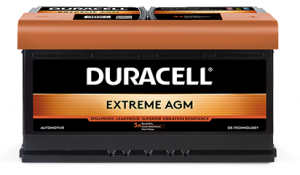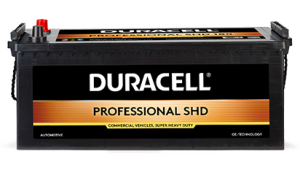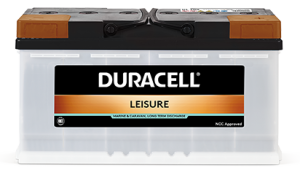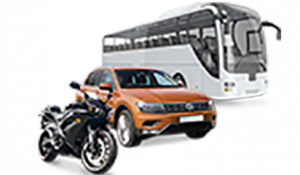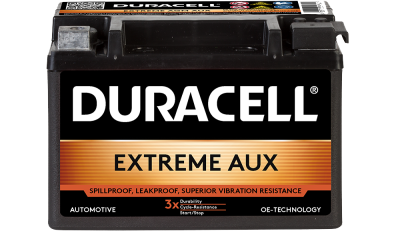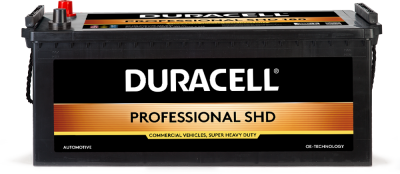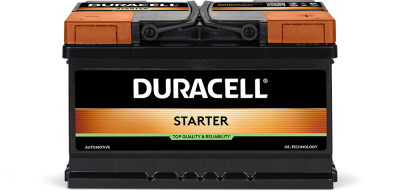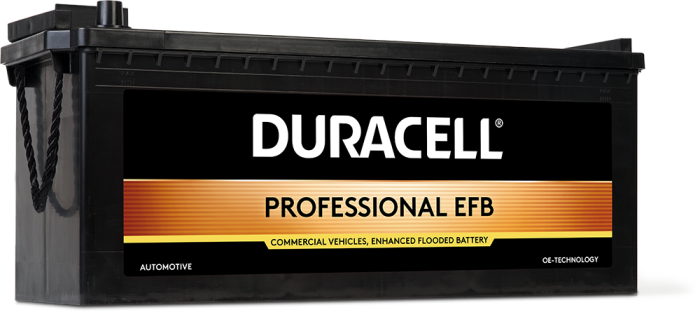
NEW:
DURACELL PROFESSIONAL EFB
INSTALLING THE POWER INTO LONG-DISTANCE TRUCKS.
The batteries employed for the electrical systems in commercial vehicles have to provide top performance on a daily basis and in addition, the steady increase in the number of comfort functions demands large quantities of energy. In
particular, this applies when long-distance truck drivers remain in their vehicles overnight and use a very large number of power consumers. Moreover, if the battery is to be integrated into the rear section of the truck frame, it must be extremely robust and vibration-resistant.

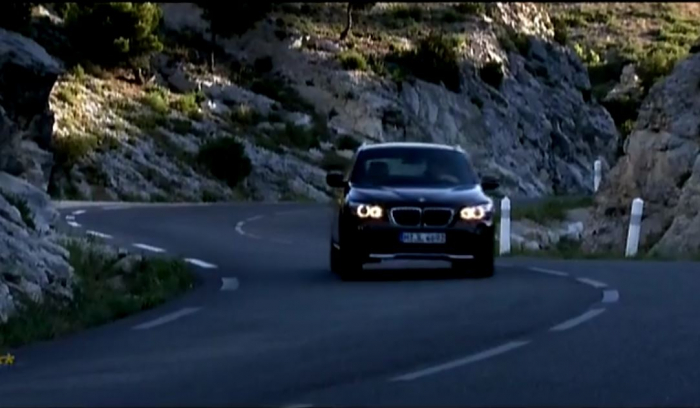
13 Reasons Why the Start-Stop System May Be Deactivated:
- Temperature Conditions: Extremely high or low outside temperatures, as well as engine temperature, can deactivate the system. Newer start-stop technologies work at temperatures as low as -10°C, while older systems may only function above +3°C.
- Interior Temperature: If the heating system hasn’t sufficiently warmed up the cabin in winter, the system may stay inactive.
- Air Conditioning or Heating: An active air conditioner or heated windscreen can prevent the system from operating.
- Stop-and-Go Traffic: Frequent stops and starts, such as in urban areas or traffic jams, can disable the system.
- Vehicle Still in Motion: The car is still coasting or rolling at a low speed.
- Minimum Speed Not Reached: Some vehicles require a minimum speed of around 4 km/h before the system activates.
- Steep Gradients or Slopes: Driving on significant inclines can deactivate the system.
- Clutch Pedal Engagement: Pressing the clutch temporarily disables the system.
- Battery Sensor Malfunction: A defective battery sensor may impact system functionality.
- Towing a Trailer: When towing, the system is often deactivated as the brake booster is not active with the engine off.
- Low Brake Pressure: Insufficient brake pressure prevents engine shutdown.
- Parking Maneuvers: Indicators such as unbuckled seat belts, open doors or bonnet, or sharply turned steering wheels can deactivate the system.
- Diesel Particulate Filter (DPF) Regeneration: During DPF regeneration, the system remains inactive. This process can take up to 40 minutes.
Note:
A relatively new issue may cause the start-stop system to stay active. This is often due to a software error in the engine control unit. Your trusted service center can assist with a software update, error code analysis, and test drive to resolve the issue.
What Could Indicate a Defect?
If none of the above situations apply, a defect may be the cause. Common issues include:
- Start-Stop Battery: A very low battery state of charge (SOC) may cause problems. In such cases, the battery should be charged, and the alternator (generator) checked. Vehicles with energy recuperation (brake energy recovery) typically use AGM or EFB batteries with a charge level of approximately 70% SOC.
- Defective Battery: In cases of total battery failure, the start-stop battery must be replaced.
Important: Never install a conventional starter battery in vehicles with start-stop systems. These batteries are not designed to handle the increased load and may fail within a few months. - Sensor Issues: Problems with temperature, external sensors, or the mass airflow sensor can disrupt system functionality.
- Clutch Switch Failure: A defective clutch switch may prevent status communication to the engine control unit, disabling the system.

1. Keep it active and on the move.
Inactive batteries start to discharge in a process during which lead sulphate forms of the battery plates and obstructs the current flow. A charger keeps the battery in shape and prevents sulphation.
2. Keep it clean.
Ensure that the surface of the battery is clean and dry using an antistatic cloth. Moisture in the engine compartment causes current creepage, which consumes energy. In addition, do not use any so-called improvement agents.
3. Keep it safe in winter.
Battery starting performance declines in cold weather. Therefore, in order to have sufficient power, switch off additional consumers such as blowers and the heating until the engine is running. Moreover, turn them off before shutting down the engine.
4. Keep it running marathons.
During short trips cars often require more energy than the dynamo can generate and recharge, which means that the battery is subject to constant discharging. Therefore, if possible take the car out for longer runs in order to charge up the battery, or even better treat your battery to an external compensatory charge. The environment will be most grateful.
5. Keep it fit for winter with an extra charge.
Frequent short trips in combination with stop and start traffic reduce the energy level of the battery during every start and drive. Give your battery an extra portion of power with external charging, especially before the first cold winter weather arrives.
6. Keep your convertible in trim during hibernation.
Are you mothballing your car for the winter? If so and the battery is to stay in the vehicle, then remove the negative terminal. The battery must remain dry and cool (but frost-free). Recharge at the latest when an open-circuit voltage of 12.5V is reached. The solution for these requirements of seasonally driven cars is provided by regular compensatory charges and charge retention.
7. Keep a booster close at hand.
Due to the sensitive electronics in the vehicle, jump-starting should generally only be carried out with a jump-start device. Car-to-car jump leads can cause voltage spikes when disconnected, damaging or even destroying the vehicle's electronics.

1. Breakdown number ONE
According to the breakdown statistics of the automobile clubs, faults in the vehicle's electrics/electronics due to weakening batteries are the most frequent cause of breakdowns - at approx. 42%. The reasons for this are often a high load from many electrical consumers and inadequate battery management.
2. the heart of the vehicle's electrical system
Parking heaters, start-stop systems, recuperation: the electrics of modern vehicles are becoming increasingly complex and require more cycle-resistant starter or on-board batteries.
3 Short distances, more power
Due to stop-and-go traffic and frequent short trips, the vehicle often needs more energy than the alternator can produce and recharge during the journey.
4 Always on - digital networking in the car
Safety and comfort functions, the anti-theft alarm system, coming- and leaving-home functions always need power, even when the car is parked.
5. shorter service life
In extreme heat or long periods of standing, the battery suffers from self-discharge. Its lifespan is shortened due to higher water consumption and corrosion.
6. sub-zero temperatures cost energy
As temperatures drop, the battery's performance also decreases simply because of poorer charge absorption. In addition, additional electrical consumers such as seat, parking or rear window heaters, etc. require a lot of energy in the cold season. need a lot of energy during the cold season.
7. hard workers for your comfort
Ventilation, seat or auxiliary heating, infotainment, ... Modern cars use the battery not only for starting, but also more and more as an on-board battery.
8. energy for the environment
Recuperation and start-stop systems make modern cars much more environmentally friendly by reducing fuel consumption and CO2 emissions.
emissions. The basic prerequisite: an extremely cycle-resistant start-stop battery that reliably delivers top performance start after start and drive after drive.
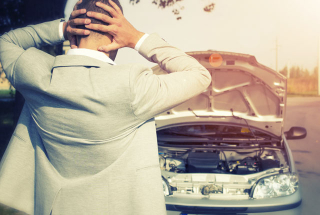
Often, starting problems become noticeable even before total failure. Common signs are:
- The starter (starter motor) works only sluggishly and can no longer start the engine.
- Often the noise the starter makes when trying to start the engine indicates that the battery is weakening.
- The charge indicator light begins to flicker.
- In the worst case, only a "clack" can be heard when starting the engine, triggered by the magnetic switch on the starter (starter motor). As optimists, we do not want to assume that this is the case!
How do starting problems become noticeable?
1. All lights in the cockpit remain off
Possibility 1 - Do you leave electrical devices (e.g. lights or radio) on all night? Then the battery has simply discharged. Start with a booster and charge the battery with a suitable charger.
Possibility 2 - You do not leave any devices switched on? After a quick start and charging the battery, it quickly loses power again. The battery may be defective and needs to be replaced. PS: A battery test at your trusted workshop provides reliable information about the condition of the battery and the on-board electrical system (e.g. regulator voltage).
2. Cockpit lights are on, but the starter does not rotate
Possibility 1 - The battery is too weak. Jump start and recharge with a charger. If the battery discharges again within a short time, look for hidden consumers. Troubleshooting tip: Measure the battery current with the ignition off. Pull the fuses, one by one, until you find the culprit. If this seems too complicated, go to a workshop and have it checked there.
Possibility 2 - The starter motor is stuck and the solenoid switch is not working. One symptom would be that the battery is low. The lights, fan and partners are working properly. A proper tap on the starter solenoid switch can now work wonders and usually ensure a successful engine start. In the worst case, this method only works once and the solenoid switch or the entire starter motor still needs to be replaced.
3. Cockpit lights, starter motor only starts the engine tiredly
Possibility 1 - Many short trips. The driving distance is not sufficient to fully charge the battery. Switch off non-essential power consumers. Drive longer distances - if necessary, charge your battery in an environmentally friendly manner at a charger.
Possibility 2 - The charging indicator is always flashing or lit. The regulator in the alternator could be the culprit, have it checked and replaced at the workshop if possible. Brush wear test: If the light goes out after you tap the regulator, the brushes are worn.
Possibility 3 - The V-belt squeals and the alternator cannot produce full power as a result. Tension or replace the V-belt while checking if the alternator moves slightly. In most cases, this is done by specialists in the workshop.

In vehicles with automatic start-stop systems, two different battery technologies are basically used, depending on the energy requirement and the required vibration or cycle resistance.
- AGM (Absorbent Glass Mat)
- EFB (Enhanced Flooded Battery)
AGM battery
- AGM - Absorbent Glass Mat: the acid is absorbed into the glass fleece and thus bound.
- = VRLA - Valve Regulated Lead Acid: a valve-regulated lead-acid battery with AGM technology
- Starter and on-board power supply battery for start-stop vehicles with highest energy demand and brake energy regeneration
- for medium and luxury class vehicles
- up to 360,000 engine starts
- Auxiliary battery (BackUp) for start-stop vehicles or electric cars with highest energy demand and brake energy regeneration
AGM technology is mainly used in start-stop systems with the highest energy demand and brake energy recovery. It is primarily used in mid-range and luxury class vehicles. AGM (Absorbent Glass Mat) is a recombination battery. The AGM battery is also used in the commercial vehicle sector, especially in long-distance trucks.
A glass mat separator absorbs the acid and leaves enough pores to allow oxygen diffusion from the positive to the negative plate. At the negative plate, the oxygen combines with lead to form lead oxide. Subsequently, this lead oxide reacts with the sulphuric acid to form lead sulphate, with water as the reaction product. The charge converts the lead sulphate back into metallic lead. The result: no water loss! However, if too much gas is produced due to too high charging voltages or extremely hot temperatures, not all of the gases formed can recombine completely. The pressure in the battery rises continuously until the safety valves open.
Changing an AGM battery
If a motor vehicle is equipped with an AGM battery as standard, it is essential to replace it with an AGM battery. In the same housing and similar performance class.
PS: Slight deviations in capacity or cold start have no effect on safe starting and optimum on-board power supply!
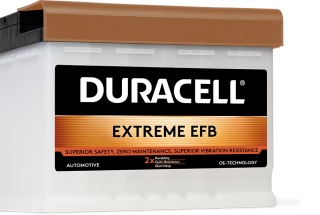
Two different battery technologies are used in vehicles with automatic start-stop systems, depending on the energy requirement and the required vibration or cycle stability.
- EFB (Enhanced Flooded Battery)
- AGM (Absorbent Glass Mat)
EFB battery
- EFB - Enhanced Flooded Battery, the cycle-resistant starter battery with liquid electrolyte.
- = AFB - Advanced Flooded Battery
- = ECM - Enhanced Cyclic Mat
- Running Bull EFB - Starter and on-board power supply battery for vehicles with high energy requirements and simpler start-stop systems or increasingly also used as back-up battery in electric cars
- for small cars up to upper middle class
- up to 270,000 engine starts
EFB technology is used primarily in simpler start-stop systems and generally in vehicles with high energy requirements. Primarily for small cars up to the upper mid-range. The battery achieves high vibration resistance and twice the cycle life (compared to conventional starter batteries). Furthermore, the carbon additives lead to a significant reduction in charging time! The EFB battery is a further development of the conventional wet battery. Special mass additives and the use of a plate scrim (fleece layer) provide additional support for the active mass. If recuperation (recovery of braking energy) is also operated in the vehicle, the EFB battery works artificially at a lower state of charge (SOC State Of Charge at approx. 70%). Depending on the driving profile, a conventional wet battery in this application will be defective within a few months due to the extremely high cyclical load.
Changing an EFB battery
If a motor vehicle is equipped with an EFB battery as standard, this may be replaced with an EFB battery or, under certain circumstances, with an AGM battery. In the same housing and similar performance class.
The start-stop system was developed to reduce CO2 and fuel consumption. In addition to an energy management system and a battery sensor, special start-stop batteries are absolutely necessary to implement this system.
AGM battery
- AGM = Absorbent Glass Mat: the acid is absorbed into the glass fleece and thus bound.
- Starter and on-board power supply battery for start-stop vehicles with highest energy demand and brake energy regeneration
- for medium- and luxury-class vehicles
- up to 360,000 engine starts
- Back-up battery for start-stop vehicles or electric cars with highest energy demand and brake energy regeneration
AGM technology is mainly used for start-stop systems with the highest energy demand and brake energy recovery. It is primarily used in mid-range and luxury class vehicles. AGM (Absorbent Glass Mat) is a recombination battery.
EFB battery
- EFB = Enhanced Flooded Battery: the cycle-resistant starter battery with liquid electrolyte.
- Starter and on-board power supply batteries for vehicles with high energy requirements and simpler start-stop systems or increasingly also used as back-up batteries in electric cars
- for small cars up to upper middle class
- up to 270,000 engine starts
EFB technology is used primarily in simpler start-stop systems and generally in vehicles with high energy requirements. Primarily for small cars up to the upper mid-range.
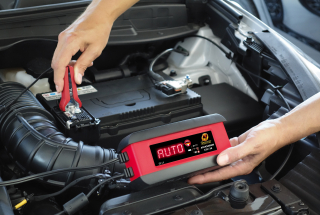
Charging of conventional wet batteries and EFB batteries:
- Before charging, check electrolyte level and, if necessary, fill up desalinated or distilled water to the max. acid residue mark or 15 mm above the upper edge of the plate. The screw connections of the battery must not remain open during charging, it is best to close them again.
AGM batteries must not be opened, refilling with water is not possible or necessary.
- Connect the positive terminal (+) of the battery to the charging clamp (+) of the charger and the negative terminal (-) to the negative clamp (-) of the charger. Only switch on the charger after connecting the battery. Switch off the charger when charging is complete.
- A tenth of the capacity is recommended as charging current. (e.g. 44 Ah: 10 = 4.4 A charging current). With an automatic charger (e.g. Banner Accucharger) this setting happens, as the name suggests, automatically.
- Charging is complete when the current drops to 0 or no longer decreases or the automatic charger switches off. Provide good ventilation during charging. Attention: Highly explosive oxyhydrogen gas forms during charging! Fire, sparks, open light and smoking prohibited!
- AGM batteries must be charged with a voltage regulated charger, e.g. Banner Accucharger (max. 14.8V)!
As a general rule, fully automatic chargers (charging voltage limitation with 14.8V) are well suited for charging the battery installed in the vehicle. If your charger has an automatic mode with voltages >15.9V, the battery must be disconnected from the on-board electronics or removed from the vehicle. In the worst case the installed control units could be destroyed by overvoltages, the resulting damage would be enormous!

The requirements for starter batteries are strongly dependent on the climatic conditions and the additional electrical/electronic equipment. Today, most new vehicles are also equipped with a start-stop system that switches off the engine when the vehicle is stopped in order to reduce fuel consumption and emissions. Conventional starter batteries can no longer fulfil this challenging task, which is why the use of special start-stop batteries with AGM (Absorbent Glass Mat) or EFB (Enhanced Flooded Battery) technology is required.
Cheap batteries are therefore often the more expensive solution, as they can lead to starting problems in summer and winter.
There is a good reason why Duracell quality batteries have established themselves worldwide!
They combine the highest starting power, further increased cold start characteristics, optimised current consumption capacity and thus improved chargeability as well as a long service life.
Duracell Tip: Use the next largest battery for your car, for which there is usually enough space. Because these are additional power reserves for your vehicle! The price difference is usually extremely small and the alternator of your vehicle is designed for it!
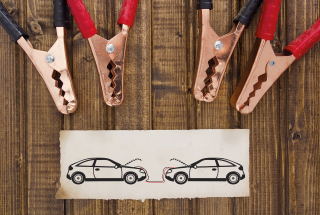
However, one thing should be noted from the outset. Namely, that in view of the sensitive electronic components in the vehicle, as a rule starting assistance should only be given by means of a Booster. This is because Car-to-car jumper cables can cause voltage spikes when disconnected, damaging or even destroying the vehicle's electronics.
Therefore, it is essential that the following procedure be strictly observed when using starter cables!
– Standardised starter cables (e.g. in accordance with DIN 72 553) should always be used when giving starting assistance.
– Observe the instructions for the use of the starter cables.
– Only connect batteries with the same nominal voltage.
– When connecting the terminals, switch off both vehicle engines!
– First connect the two positive terminals (1) with (2). Then connect the negative terminal of the assisting vehicle (3) with (4), the blank metallic point on the vehicle requiring assistance, away from the battery. (Observe the instructions of the vehicle manufacturer.)
– Now start the vehicle needing assistance for a maximum of 15 seconds. Do not start the assisting vehicle.
– When disconnecting the terminals, remove the cables in the reverse sequence to the above.
Attention: The car battery is not always installed in the engine compartment, but can also be located in the interior/passenger compartment or luggage compartment. The procedure of the jump start remains unchanged!
Get through the winter safely and well!


